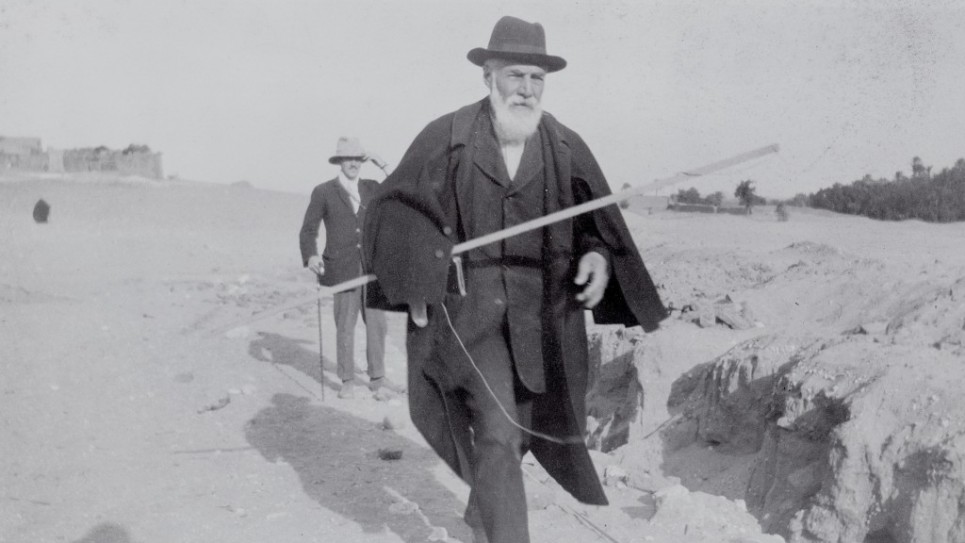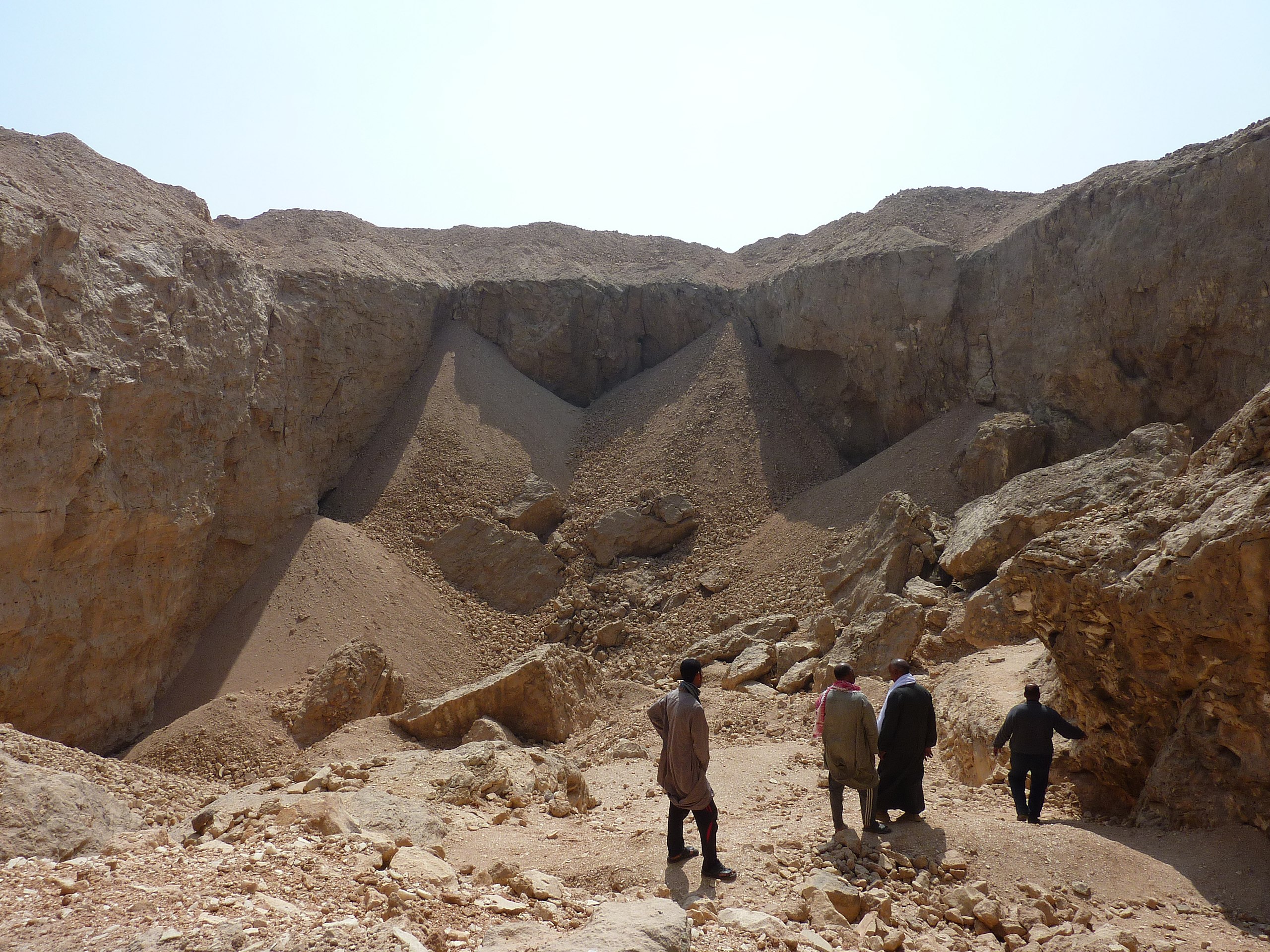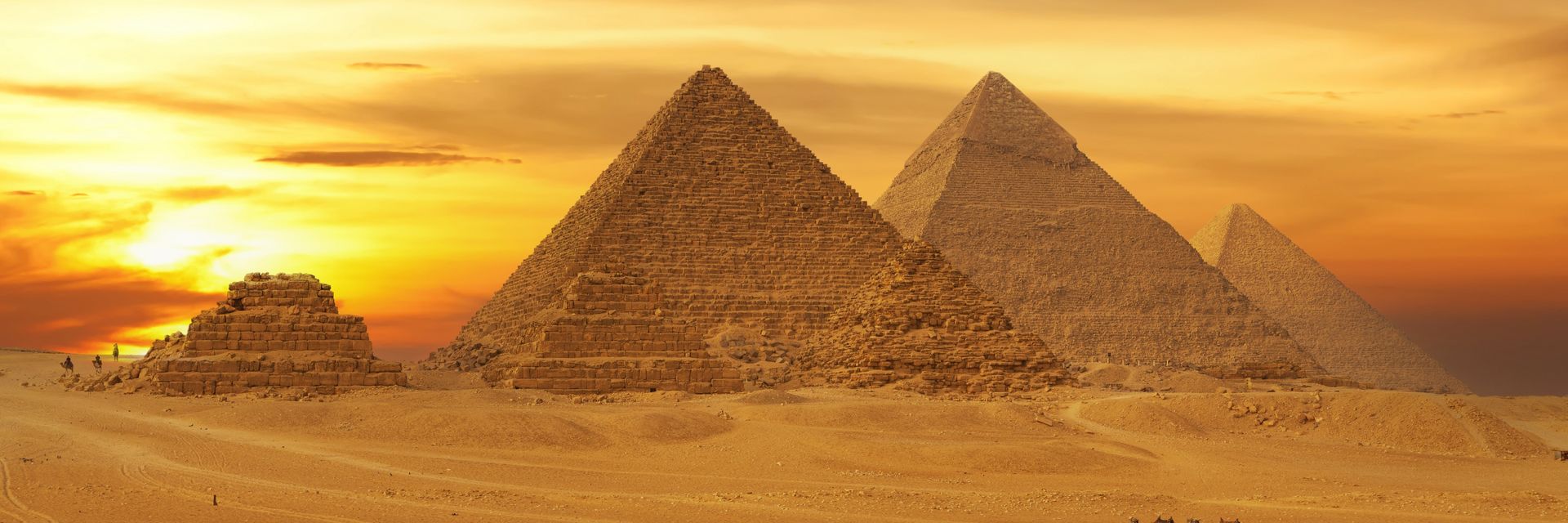Prior to recent archaeological research, there existed many fanciful theories for how the pyramids in Egypt were constructed.
◊
Steeped in the allure of deep prehistory and with an inspired, auspicious appearance, the Great Pyramid of Giza struck awe in the heart of its earliest chronicler, Greek historian Herodotus, who came upon the great wonder of the world during his journeys around the year 450 BCE.
Herodotus was astonished by the grandeur and seeming perfection of the pyramid: Four identical triangular faces on a square base rising approximately 480 feet above the Giza plateau. Herodotus had never seen such a tall, human-made structure. And, although he couldn’t have known it, the pyramid that caught his fancy was some two millennia old when he first set eyes upon it.
In his Histories, the ancient historian attempted not only to describe its appearance but to hazard a guess as to its construction. Just how were those enormous limestone blocks raised to such great heights? Herodotus proposed that there were a number of “machines” in use at the time that moved the carved stone blocks from one level of the pyramid up to the next without the use of ramps.
Today, historians and archaeologists believe that Herodotus’s description was a product of his own imagination. It certainly lacks any documented proof. But, lacking other explanations, his story was repeated in later histories of the ancient world.
Tour Egypt’s most impressive and majestic pyramids in this comprehensive look at these ancient burial monuments.
Historical Attempts to Unravel the Mysteries of the Pyramids’ Construction
Herodotus was the first, but not the only, scribe who attempted to unlock the silent mysteries of the Great Pyramid and the many other pyramids that dotted Egypt’s landscape. Four centuries after Histories, in the first century BCE, another Greek historian named Diodorus Siculus came through the desert to encounter these great monuments at Giza. At this point, late into the days of the Greek Empire, the Great Pyramid was already acknowledged as one of the Seven Wonders of the World. In his Bibliotheca historica, Diodorus postulated that the Egyptians used ramps to move the blocks, which later, having served their purpose, were dismantled, accounting for their being found nowhere in Egypt.
Not every writer of antiquity was awed by Egypt’s pyramids. First-century CE Roman author Pliny the Elder dismissed them with a flip comment about “the Pyramids of Egypt, so many idle and frivolous pieces of ostentation.”
Interest in the pyramids swelled beginning in the 18th and 19th centuries with the rise of the Imperial Age and the British Empire’s colonization of what used to be called “the Orient.” Explorers, many self-funded, swarmed the Giza plateau, seeking to discover clues that would lead to publications explaining the pyramids’ construction secrets to their inquisitive audiences in Germany, France, England, and the United States.
 British explorer Flinders Petrie examines remains of stonework at Abydos, Egypt, 1922. (Source: The Petrie Museum of Egyptian Archaeology, via Wikimedia Commons)
British explorer Flinders Petrie examines remains of stonework at Abydos, Egypt, 1922. (Source: The Petrie Museum of Egyptian Archaeology, via Wikimedia Commons)
No one would confuse the imaginatively named Flinders Petrie (above) with Indiana Jones, but he is nonetheless considered the “father of modern Egyptology.” He wrote that pyramid construction involved the use of straight or zig-zagging ramps. His careful analysis of the remains around the pyramids was influential in later studies.
The Rise of Pseudoscience in Egyptology and ‘Pyramidology’
Alongside serious scientific approaches to Egyptology arose somewhat more frivolous attempts to explain what was unknown about the pyramids’ construction. Although purveyors of these ideas took themselves seriously, scientific methods have put many of their theories to rest. But a number of these pseudoscientific conjectures persist, including the following:
Aliens
Many people still believe that these amazing monuments from millennia ago could not have been conceived and formed by human hands. Hence, humans had nothing to do with them! Scores of books have been written over the past century or so, promising to unveil the covert truths of the source of these giant structures.
Perhaps the most prolific of these authors has been Erich von Däniken, whose celebrated best-seller of the 1970s, Chariots of the Gods?, examined ancient texts and art to conjure up his theory that Earth has been visited by superior alien civilizations for thousands of years. Well before Earth’s own “Space Age,” these alien astronauts were busy not only sharing interplanetary wisdom with Earthlings but also gifting us with shining limestone structures to memorialize their interaction with us.
Däniken hit the jackpot with his belief that the pyramids were constructed with alien technology; Chariots sold over 70 million copies worldwide and has been turned into films and television programs.
Numerology
Some numerologists, inspired by 17th-century British astronomer John Greaves, contend that the Great Pyramid of Giza is encoded with specific numerical patterns that hold supernatural and even prophetic significance. The concept of the “Pyramid Inch” postulated that the Great Pyramid was developed from a mystical measurement close to, but not identical with, the scientific inch. This special inch was supposed to have led to the pyramid’s length around its base corresponding to the number of days in a year, and other logic-defying measures. No evidence of this has ever been found by direct examination.

John Greaves, English mathematician and surveyor of the Great Pyramid (Source: Wellcome Images, a website operated by Wellcome Trust, a global charitable foundation based in the United Kingdom, via Wikimedia Commons)
Divine Inspiration
John Taylor was a 19th-century thinker whose writings, including The Great Pyramid: Why Was It Built and Who Built It?, claimed that the Great Pyramid of Giza was divinely inspired. He wrote that the structure was not built by Egyptians but by the biblical Hebrews, and suggested that passages in the Old Testament confirmed his theory.
The ‘Golden Ratio’
Our dubious guide, John Taylor, is also associated with this nifty proposition, which asserts that the Great Pyramid’s dimensions were intentionally designed to embody the Golden Ratio as a divine principle. He intimated that the pyramid’s builders had access to advanced knowledge of mathematics and geometry, and they embodied the proportions of the pyramid with this ratio.
‘Lost’ Technology
Some theorists reach back to fabled earlier human civilizations, like the Atlanteans or the Lemurians, that supposedly had advanced technology later lost when these societies disappeared. As late as 1995, author Graham Hancock theorized in his book Fingerprints of the Gods that an “inspired” civilization that died out once had the technology to easily construct the pyramids. Sad to say, any evidence of this vanished along with these conjectured cultures.
Contemporary Archaeology’s Spectacular Finds Point the Way to New Theories
Egyptology and “pyramidology” haven’t left us, but these lines of inquiry have matured significantly in the 21st century. Two ground-breaking discoveries in recent years have brought us quite a bit closer to answering the two fundamental questions that have never been satisfactorily explained since the time of Herodotus: (1) How were the quarried blocks of limestone transported to the building sites of the pyramids?; and (2) How were the blocks raised into position?
 Main quarry at Hatnub, Egypt (Source: Hannah Pethen, via Wikimedia Commons)
Main quarry at Hatnub, Egypt (Source: Hannah Pethen, via Wikimedia Commons)
In 2018, archaeologists working at the site of an ancient quarry called Hatnub in Egypt’s Eastern Desert were astonished to uncover a 4,500-year-old ramp carved out of stone that appears to have been used to raise limestone blocks out of the quarry. This central ramp was flanked by staircases on either side, with holes placed at regular intervals up the stairways.
While not offering direct proof of a method used at Giza, the post holes suggest a rope-and-pulley system where massive blocks could have been maneuvered onto sleds. The sleds would, in turn, have been tied with ropes to posts stationed along the way up the ramp. Rather than depending on sheer manpower to push and pull the stones up an incline, the ropes would have made it a somewhat easier task to move them along until they were loaded onto boats going down the Nile.
The Final Clue: A Lost Branch of the Nile River
In 2024, scientists using a series of sophisticated analytic tools announced that they had discovered a long-lost, heretofore unknown branch of the Nile River that followed the line of the pyramids built in Giza, Abusir, Saqqara, Dahshur, and even more sites that are currently surrounded by nothing but desert.
In 2013, the oldest papyrus scroll was discovered near Tura, a limestone quarry on the banks of the Nile. This scroll, called the “Diary of Merer,” is a record of a ship’s captain responsible for carrying food and equipment to workers at the quarry and blocks of limestone down the river to the pyramid sites.
The team employed radar satellite data to image a former riverbed deep below the sand’s surface. They followed this with both geophysical surveys and sediment core analysis to confirm the existence, up to around 2200 BCE, of a branch of the Nile, named the Ahramat, that ran directly past all these sites. The river branch was 40 miles long and up to 1,640 feet wide and 82 feet deep. Boats could have easily traveled up and down the Ahramat from quarries in the south of Egypt to the pyramid construction sites until, around 4,200 years ago, drought and desertification caused it to dry up and then be covered by Saharan sands.
_(14577194517).jpg) Illustration showing transportation of a large statue on a sled (Source: The Source of Civilization: Egypt and Chaldaea, via Wikimedia Commons)
Illustration showing transportation of a large statue on a sled (Source: The Source of Civilization: Egypt and Chaldaea, via Wikimedia Commons)
This newly discovered, extinct branch of the Nile explains the causeways that are noted on the sites of the pyramids leading from the structures to remains of temples. Formerly believed to be only ceremonial, it now appears that the temples and other structures were built riverside and served as harbor points to offload the limestone needed to construct the pyramids. Engineers of the period could have used the Nile’s regular floods as “hydraulic lifts” to more easily move the stone blocks from boats to the causeways.
Tantalizing Theories Offer Clues but Not Proof
It must be stressed that these findings do not offer definitive answers. Just like explorers of the 19th century and earlier, we may feel closer to understanding precisely how limestone was carted from quarries to construction sites, but as yet, there is still no direct evidence that shows exactly how these imposing burial chambers for pharaohs were constructed. Wondrous discoveries have been made, and scientific research and exploration continue. But still, these silent monuments to a mysterious era in human history have not yielded all their secrets.
Ω
Kevin Martin is Senior Writer and Associate Editor for MagellanTV. A journalist and communications specialist for many years, he writes on various topics, including Art and Culture, Current History, and Space and Astronomy. He is the co-editor of My Body Is Paper: Stories and Poems by Gil Cuadros (City Lights) and resides in Glendale, California.
Title Image: Pyramids along the Giza plateau (Source: Adobe Stock Images)


